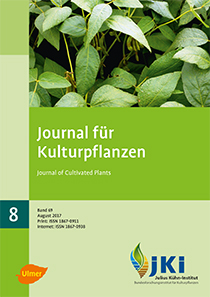Glyphosate use with different application technique – late application in winter wheat
DOI:
https://doi.org/10.5073/JfK.2017.08.03Keywords:
Desiccation, dropleg, glyphosate residues, field trials, herbicide, late applicationAbstract
Glyphosate was used in a field trial in winter wheat shortly before harvest for weed control and desiccation. Application was done with conventional and dropleg application technique at growth stage BBCH 89 of winter wheat. The analyses covered glyphosate and AMPA residues at the time of harvest, 7 and 16 days after application on the outside of the wheat grain, chaff and straw. Depending on the application technique the results demonstrate varying residues. The highest residues with up to 6 mg/kg were found on the wheat grain with conventional application technique. With dropleg application technique significant lower residues were determined. In straw, glyphosate residues were higher for dropleg application technique in comparison to conventional technique. The level of residues of grain and straw decreased with increasing waiting period. The obtained results suggested that the use of dropleg application technique can reduce residue amounts on grain. The dropleg application technique can only be used for upright cereals.
Downloads
Published
Issue
Section
License
The content of the journal is licensed under the Creative Commons Attribution 4.0 License. Any user is free to share and adapt (remix, transform, build upon) the content as long as the original publication is attributed (authors, title, year, journal, issue, pages).
The copyright of the published work remains with the authors. The authors grant the Journal of Cultivated Plants, the Julius Kühn-Institut and the OpenAgrar repository the non-exclusive right to distribute and exploit the work.







